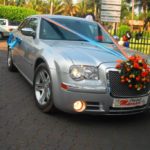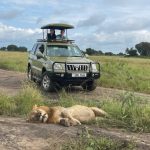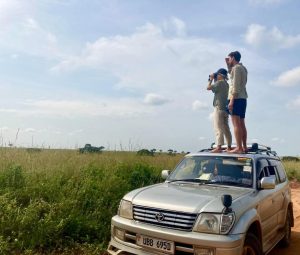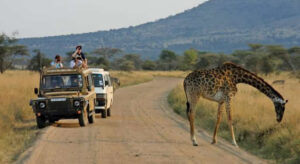It is really astonishing why the African Big 5 are called so because the name is very controversial with the small size of some of the Big 5 like the Leopard. The phrase was invented back in the 1800s by the trophy game hunters basing on how challenging and dangerous hunting these species on foot was compared to the rest of the wild animals making them the biggest prizes hence the “Big Five” and they include the African Elephant, African Lion, African Leopard, the Cape buffalo and the Rhino.
Back in the nineteenth and the early twentieth centuries, the royals in Europe wanted so much to own an African hunting trophy with the slogan “the larger and more erratic the beast, the better,” but in Uganda the term Big five is used to characterize safari royalty, noteworthy selling point for a safari and the exclusive sightings and they can be found in Murchison falls national park, Queen Elizabeth national park, Lake Mburo national park, Ziwa Rhino sanctuary, Kidepo national park and in reserves like the Uganda Wildlife Conservation Education Center.
But since the Big five list is no longer determined by the size and the difficult to hunt them, we can firmly adjust the list because Uganda is richly hallowed with a number of big endangered, charismatic and beautiful wild animals that are not featured on the list and the most remarkably is the Mountain gorilla which is perhaps the most desirable Africa safari animal in Uganda. There are a lot of thought-provoking facts about the African Big 5 and below are the most interesting facts you should know about them.
INTERESTING FACTS ABOUT THE BIG FIVE
African Elephant

The magnificent African elephant (Loxodonta Africana) is also among the big 5 animals because despite its size, it’s capable of hiding in thick bush and more likely to charge than any of the big 5 plus the outstanding skill of communication across large distances at a low frequency that can’t be heard by humans, through sounds like trumpet calls, touch, vibrations in the ground which they detect through their bones , body language, scent, through seismic signals all make the elephant very unpredictable, very hard and deadly to hunt making it qualify as an African big 5 animal.
Amazingly, the elephant is the largest land mammal with the adult bull standing up to 3m high and weighing up to 6000kg on average and they reach their full size at 35-40years which is a half their lifespan as in the wild they can live up to 60-70years , herbivores, considered as a keystone specie due to its contribution to the environment, with thick, nearly hairless skin, avaricious and flexible trunk with mad skills, upper incisors forming perfectly curved, long ivory tusks and the large comical shaped ears which act as the differentiating factor among the three species of elephants namely, African savanna( bush), African forest elephant and Asian where the ears of the African elephant are larger and defined as being shaped like the African continent with the concave back while the Asian ears are shaped like the Indian subcontinent with convex or level backs.
The fascinating and incredible fact about the African elephant trunk which is also a difference among the elephant species, the African elephants have two fingers at the tip of the trunk while Asians have one, the trunk has around 150,000 muscle units which make its skills very spectacular, it is the most sensitive organ found in any mammal, the trunk is used to suck water for drinking and it can contain up to 8 liters, it is also used as a snorkel when swimming and the Asian elephant has been recorded while picking up a peanut, shell it, blow the shell out and eat the nut using the trunk.
It is so enthralling that the elephant has got a thick skin about 2.5m in most places that’s why it hesitates not to migrate from one place to another in search for food, the folds and the wrinkles on its skin can hold water 10 times more than a flat skin can which cools it down, the regular dust and mud baths help it to keep clean and also protects the body from sunburn. The elephant is a constant eater which can spend a 3rd of its day eating and can eat 150kg of food per day depending on the habitat and season, they are totally herbivores so they feed on leaves, grass, fruits, roots during wet season and when it is particularly dry it feeds more on woody parts of trees and shrubs like twigs, barks and branches. The ever green savannah vegetation in most of the Ugandan national parks like Queen Elizabeth national park, Murchison falls national park, Lake Mburo national park, Kidepo national park, Semulik national park is a great habitat for the elephants.
More about the superb facts about the brilliant elephant, it is polygynous breeder and the coituses are most common during the ultimate of the wet season where the cow in oestrus releases a chemical (pheromones) in her urine and vaginal secretions as a direct signal to the bulls that she is ready for mating, the robust bull will collect a chemical sample with the help of the trunk to the vomeronasal organ with in 14-16 days before the end of the oestrus cycle of the cow. The gestation period of a cow is 2 years and gives birth alive to a huge calf that can weigh 120kg, takes 20 minutes after birth to stand, an hour to walk and after 2 days its able to join the herd, this survival technique favors their movements in search for food in different habitats and their life span is between 60-70 years, however the natural hazards like diseases, draught affects them hence reducing their life span.
African Leopard

The grand leopard (Panthera pardus) is the most elusive and dangerous animal in the world especially when wounded, it hunts back which earns it a lot of respect from the hunters making it so hard, very erratic and deadly to hunt making it qualify among the African big 5. A large carnivorous feline and one of the five extant species with the lion (panthera leo), jaguar (panthera onca), tiger (panthera tigris) and snow leopard (panthera uncia) in the genus Panthera, a member of the solitary cat family, the most indefinable and also the smallest among the African big 5, elephant, rhino, buffalo and lion. Its fur is normally tawny with dark rosette shaped markings, the whitish spots on the back of its ears are believed to play a role in communication while the white tips on its tail may act as follow me signal especially to the cubs in the thick grass, relatively short legs and long body with a large skull.
Mesmerizingly, a Leopard is naturally shy but only before its threatened, wholly nocturnal because it is most active between sunset and sunrise, very sneaky, most seldom seen because it spends many of the daylight hours hidden and commonly found almost in all habitats which provide satisfactory cover like most of the Uganda national parks for example Queen Elizabeth national park, Murchison falls national park, Kidepo national park, Lake Mburo national park, Mt Elgon national park and forest reserves like Toro-Semliki wildlife reserve where savanna vegetation is rich.
The solitary big cat is a carnivore and it haul large kills of average size prey with a body mass ranging from 10-40kg and the most favored species are the ungulates like the common duikers, bushbuck, impala and chital, primates preyed include the white eyelid mangabeys, grey langurs, guenons, it also attacks smaller carnivore like bat-eared fox, genet, black backed jackal and cheetah. This African big 5, leopard is sexually dimorphic, the adults only meet during the mating season, the male is larger and heavier than the female, the leopardess’ cycle lasts for 46 days, usually on heat for 6-7 days, the gestation period lasts for 90-105 days, gives birth in the crevice among boulders, cave, hollow tree orthidic, the cubs are born with closed eyes which open 4-9 days after birth and the generation length is 9.3 years.
African Lion

The splendid African lion (Panthera Leo) commonly known as the king of the jungle or the king of the beast is another African big 5, the most dangerous among them, from the cat family and it’s the second largest in the family, extremely a skillful, apex, keystone predator and adept hunter which counts human part of the prey, very dangerous and deadly when wounded just like the other big 5, it hunts back so you ought to make sure that your first shot meets your expectations, a lion is a very social animal so it rare to find it moving or hunting alone making it so hard to hunt hence qualifying among the African Big 5.
The king of the beast is a well- built cat with short rounded head, round ears, a reduced neck, its fur differs in color from yellowish red, dark brown and light buff to silvery grey, the newly born cub has dark spots which fade as it reaches adulthood, the only obvious sexual dimorphism in the cat family where the males have broader heads and prominent naturally brownish and tinged with yellow rust mane covering most of the head, shoulder, chest and the neck, the tail ends in a dark hairy tuft with a long hard spine formed from the final fused sections of the tail bone.
Amazingly, lions are the most sociable of the large cats living in slackly operational feelings of pride with about 15 members which include of a few adult males, females and cubs, the lionesses are responsible for hunting for the entire pride and because of its hypercarnivore nature, its prey consists mainly of mammals particularly ungulates like antelopes, buffaloes, warthogs, hares, giraffes, zebras among others. The male heads the pride after a serious fight among the other males and marks its territories by a very loud scary roar but unfortunately if the ruling male is killed by another male, he kills all the cubs to tarnish and raise all the attachments with the past male, the lioness is expected to give birth to new cubs of his off the new ruling king of the pride.
So charming how a lion is inactive for almost 20hours a day, their activity usually peaks after dusk during the period of training, decamping and socializing, they spend an average of 2 hours walking, hunting, 50 minutes eating but they can be active at any time from dusk till dawn when the hunting most often takes place by the female lions and only helped out by the males on large preys. They inhabit shrublands, grasslands, areas with tresses and grass, savanna and in Uganda lions are found in the big national parks like Queen Elizabeth national park with the special section of the tree climbing lions (ishasha), Murchison falls national park, Kidepo national park and others like Lake Mburo national park.
It is so enthralling that lions are polyestrous, they have no specific time of mating like some of the mammals, most of them reproduce at the age of 4years, gestation period of 3 ½ months, they give birth alive to 2-6 blind cubs until 2 weeks when they are able to see properly, they have no den as their home but the lioness conceal the cubs in gullies, rocky outcrops or in thick bushes and at 6 weeks the cubs will be introduced to the pride and their safety is for all the members in the group, life span is 10 years in the wild but its rare for the males to reach or exceed 10 years because of the wounds they get from fighting with the other males which makes their lives shorter.
African Buffalo

The marvelous African Buffalo scientifically known as Syncerus caffer is among the African Big five lined with the lion, leopard, elephant and rhino, herbivore, large sub- Saharan African bovine, the largest typical subspecies, robust specie with a shoulder height of 1.0-1.7m, head and body length can range between 1.7-3.4m, short but thickest legs which results to relatively short standing height, long but stocky body,
most notorious among the big game, known as the black death” or the “widow maker” due to the estimates that it gores and kills over 200 people every year, very irascible, unpredictable, brisk runner which can cover 37 miles per hour and very dangerous especially when wounded, it will obviously attack the pursuers and because of this, it’s considered prize trophies a title for the African big 5.
Surprisingly, a buffalo is one of the most successful grazers in Africa and this is conceivable by its tongue and wide incisor row to eat grass very quickly than any other herbivores, buffaloes can feed on tall coarse grasses by the help of the herds which cut down grasses and make way for more discerning grazers. They prefer impenetrable cover like reeds, thickets, floodplains, mopane grasslands, savannas, forests and swamps, they require water daily, that’s why they can’t stay in compressed or depleted areas for long, they depend on recurrent sources of water.
Impressive, the black death(buffalo) only mate and give birth during rainy seasons, the birth peak hits hard at the beginning of the season and mating later, the cows are quite elusive which attracts a number of bulls guiding the cow in heat. At 5 years is when a cow expects to calve for the first time, gestation period of 11.5months, the calves suckle for a year and half, they are fully dependent on the mother during this period, they remain hidden in the thick vegetation for the first few weeks and fully taken care for by the mother and when introduced to he heard, its every member’s responsibility in the herd to take care of the calves. The maternal bond between the cow and the calve is stronger than in other bovids and it only halts when the new calve is born. The young males at 2years they live with the mothers for the bachelor groups, part of the buffalo’s nature, they suckle from behind pushing their heads in between the mother’s legs making them fully bovids.
The widowmaker (buffaloes) spends most of the time in a herd of about 50-500 members which include, related females, high ranking males, their off springs and it’s surrounded by sub herds of subordinate males and old or invalid animals. The calves are kept in the center of the herd to keep them from the predators like lions, the herd responds to the anguish call of a threatened member and tries to rescue it but the calf gets more attention not only from the mother but from the entire herd which engages in the mobbing behavior when fighting and this dissuade predators. They are robust critters which favors their well being in all kind of habitats, from lowland rainforest to semi-arid bushland to coastal savannas as long as there is a source of water and in Uganda, they can be found in the some of the big national parks like Queen Elizabeth national park, Murchison falls national park, Lake Mburo national park and Kidepo valley national park.
It’s no disbelief that buffalos have few predators and they are very capable of fighting and defending themselves against and killing lions the greatest enemy and other however this member of the big 5 is vulnerable to many diseases plus those shared with domestic cattle like corridor disease, foot and mouth and bovine tuberculosis and habitat loss which reduce their lifespan of 18-20years in the wild and 20-30years in captivity.
African Rhinoceros

The stunning Rhinoceros commonly known as the rhino is also among the extant “big five” from the Rhinocerotidae family, among the odd-toed ungulates, browser specie, habits in the woodland, savanna, grassland, has a unique physical appearance with flat broad mouth, short neck, broad chest, enormous body, relatively large head with a prominent muscular hump, has 2 distinct horns which are not like for the rest of horned mammals on its snout one larger than the other almost a meter in length, they are made of keratin packed together very tightly, debauched runner which can cover 30km per hour, very powerful, tough hide, the aggression when provoked or hurt which makes it charge and attack the predator heroically more than any other animal, this rewards it great respect from the hunters making it prize trophies hence qualifying among the African big 5.
Surprisingly, the fabulous rhino has a poor vision or sight which makes it charge without cause but don’t be fooled because its senses of smell and hear are outstanding thus making the poor eyesight less of a problem. The rhino is a true herbivore and the largest pure grazer with square lips which help them graze their favorite food branches, bushes and plants, drinks 2 times a day when the water is available but in dry conditions, it can push to 4-5 days without drinking, spends almost a half of the day eating, 1 and 1/3 resting and the remaining portion of the day doing the various other things like wallowing in mud holes to cool down.
Just like the term Big Five has nothing to do with the size, the white rhino as well has nothing to do with being white, in fact the specie name takes its root from Dutch meaning “weit”, (wide) referring to the wide muzzle of the animal, it is slate grey to yellowish brown in the color. They communicate through different sounds like squeals of distress, bellows, panting contact calls, grunts and snorts during courtship and growls when threatened. The males display signs when threatened like, wiping its horn on the ground, a head low posture, ears on the back together with snort threats and shrieking for the herds to be on point.
Fascinating, the rhinos also live in herds or crashes of about 14-20 members with the females being the majority, sub-adult bulls often congregate in association with the adult cows, most adult bulls are solitary, the dominant bull rules the herd and marks its territory with excrement which is laid in piles of about 20 to 30 and urine to warn the trespassers. They as well wipe their horns on bushes 10 times an hour while scraping with their feet before urine spraying as a way of emphasizing the territory.
Another exciting fact about the rhino, the females mature sexually at 6-7yrs while the males between 10-12years, the courtship is always a difficult stage, the cow is forced most times to go extreme of screaming ad acting aggressively when the cow is approaching but this doesn’t scare away the bull, it blocks and chases the female while squealing loudly every time the cow tries to live the territory. When ready to mate, the cow curls her tail, gets into a stiff stance during the ½ hour copulation and the breeding pair stays together between 5-20 days before they take separate ways.
It’s a white-knuckle that the gestation period of a rhino is 16months, a single calf is born and it usually weighs between 40-65kgs, tottering for the first 2 to 3 days, weaning begins at 2 months but a calf can suckle for 12 months. Due to the rhino’s hard rough skin and aggressiveness, it has no predators except humans which has a lot to say about their life span of about 40-50 years in the wild.
In Conclusion, Uganda is among those few countries where you can have an encounter with the famous Big five while on any safari. Would you love to get chance to encounter the Big five out in the wild, we at Mumwe Safaris will be more than happy to organize for you a Big Five safari in Uganda at affordable rates. Just get in touch with us by sending an email to info@ugandacarrentalservices.com or call us now on +256-700135510 to speak with the reservations team.
By Gloria Nalubega










Related Articles
Self Drive Uganda 2026: Essential Tips & Road Rules
Uganda Elections 2026: Safety Guide for Safari Travelers
2026 Uganda Safari Guide: Gorillas, Primates & Wildlife